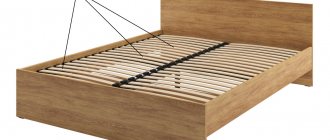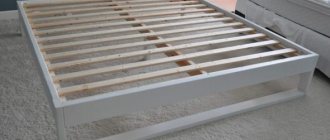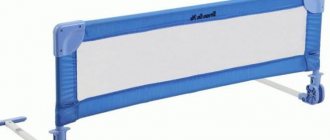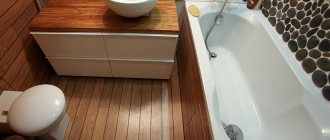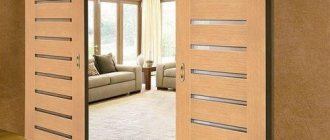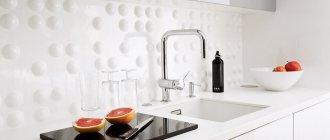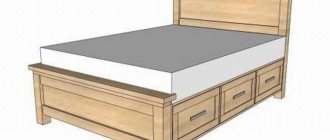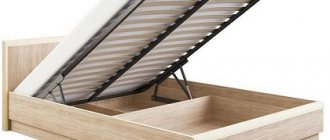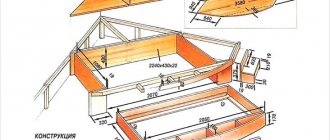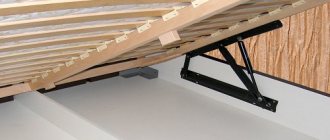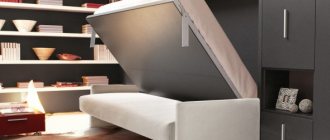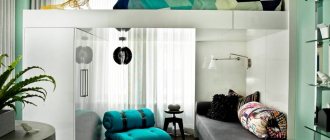For beds, slats can be made exclusively from wood. The most commonly used are birch and poplar. This material was chosen for its flexibility and resilience. Wood also contributes to excellent ventilation of the mattress.
A double bed with slats is an ideal orthopedic sleeping option.
Experts believe that 30 slats are enough for a double bed, and several times less for a single bed. Manufacturers do not adhere to this opinion and place 20-22 pieces. But if you decide to make slats and a bed with your own hands, you can independently calculate their number.
Double bed option with a standard set of slats.
The benefits of making furniture yourself
Among the advantages of making your own bed and slats, the following factors are noted.
- Environmentally friendly. Natural material, that is, wood, cannot adversely affect human health.
- Durability. A product made with your own hands will last for many years. The bed can withstand heavy loads, which confirms its strength.
- Custom size and design. The bed will be made with your own hands according to your drawings. You can adjust its size and shape to the desired parameters. You don't have to look for a place to place a large bed.
- Saving. This applies not only to indoor space, but also to funds. You independently calculate the amount of material needed and purchase them. This will cost several times less than buying a ready-made product in a store.
Option for self-installation of lamellas
Grate or solid bottom
Beds equipped with slats have practically replaced spring structures with a solid bottom from the market. Characterized by the presence of the following positive qualities:
- the quality of the slatted base is high, the cost is reasonable;
- in case of breakdown, replacement of individual elements is possible;
- under regular and intense loads, the sleeping place will not begin to creak;
- a specific arched shape guarantees a spring effect under significant loads;
- the free space between the slats helps to establish natural ventilation of the mattress and sleeping area;
- the slats take on most of the load; contrary to popular belief, similar functions are assigned to the bed frame;
- improving the orthopedic properties of the sleeping place;
- uniform load distribution over the entire surface.
Beds with a solid base are no longer in demand because:
- negative impact on the spine during rest;
- the bottom must be replaced if there is minor damage or cracks;
- lack of natural ventilation.
Work order:
- To install in the center of the frame, saw off a partition 20 cm high from plywood;
- Using self-tapping screws, pull a 5x5 cm beam, pre-cut to size, to it;
- From the bottom of the side panels at a height of about 20 cm, fix the beam with self-tapping screws (the future orthopedic base will be located on them);
- Using a tape measure and a pencil, mark the middle of the future headboard and foot of the bars and then, focusing on them, insert the middle bar
- Now, with the help of aluminum corners and self-tapping screws, you can fix all the main corner joints inside (the structure will immediately become rigid and stop wobbling);
- Using self-tapping screws in the center of each bed, tighten another beam;
- Outline the contours of the future headboard by placing them on the foam rubber and cutting them out with a margin of 15 cm so that they can be folded on top and sides, having previously smeared the surface with glue.
- On the wrong side, stretching the fabric, do the same;
- Place foam rubber on the head part blank and secure it with a stapler;
- Cover the front side of the head part, fixing the fabric with a shinil;
- Upholster the entire bed frame in the same style;
- Fold the outer casing and secure with self-tapping screws;
- Using aluminum corners, also tighten all joints with self-tapping screws;
- Lay the product on its side and install the bottom of the future box;
- Make a recess in the partition so that the crossbar does not rub when the gas lift moves;
- Fix, adjust and tighten the gas lifts to the sidewalls and frame;
- Measure the required length for the lamella, so that it extends 1.5 cm onto the frame (these additional overlaps are needed to install the lat holders);
- Attach the slat holders using a furniture stapler;
- Now, under pressure, the lamellas will clearly spring and not creak (thanks to the plastic lat holders targeted to the inside of the frame). Having installed all the slats for the bed in this way, it will become rigid, strong and stop swaying.
- Hiding the fastening points, cover the back of the headboard with non-woven material;
- Place a new mattress on your bed and you can enjoy a sound and restful sleep.
The slats on the bed are creaking: what to do?
To assess the scale of the problem, you need to take a closer look not only at the slatted base, but also at the mattress, support slats, and also at the lifting mechanism, if any.
Why do the slats creak?
The base of a bed with slats creaks most often for two reasons:
- The fasteners were not tightened properly.
- Wooden elements rub against each other.
If the creaking of the lamellas began a year or two after purchase, then the wood may also be drying out. This process is completely natural and is influenced by the material of the boards from which the slats are made, as well as the microclimate of the room. Material with low hygroscopicity practically does not creak. Indoor humidity of less than 50% slows down the drying process of the boards and, thereby, extends their service life.
What to do if the slats on the bed squeak
If you determine that it is the slats that are creaking, then you need to click on each one and determine which of the slats the sound comes from. They should also be checked for chips, cracks and other integrity problems. If damage is detected, the lamellas must be replaced. This will help remove the squeak and correct the situation.
A few tips for a novice master
If you are not renovating, but making a bed yourself, you need to remember the following basic rules on how to make slats for a bed with your own hands:
- The minimum number of slats in a single bed is 15 pieces. In a double design, respectively, - 30.
- The distance between the slats should not exceed the width of the slats.
- The lamellas can be secured using special tips or frame stands.
Important! With all the advantages, flexible bed slats are the weak link. If you don't want to constantly repair the bed, you can replace them with two 12 mm thick plywood sheets. The sheets must first be connected to each other and then to the frame to form a rigid structure. To provide ventilation, make several holes in the plywood sheets. In addition to the fact that the structure is durable, such a bed will not creak.
Types of manufacturing defects in the production of laminated wood
Experts recommend constantly monitoring length losses when cutting tenons and losses when cutting a spliced lamella. Do not forget that the shorter the final product is produced, the more we throw into sawdust; it is more profitable to make longer products.
Defects obtained when working on a splice line can be divided into:
- Under-pressing - when there is an empty distance between the studs along the length, if a defect occurs, you need to look at the pressing pressure and the quality of the resulting studs.
- Under-resining - when little resin is supplied to the spikes, the resulting semi-finished product will have insufficient physical and mechanical properties.
- Getting a step - when the workpieces have different widths or thicknesses, or the lamellas are not positioned evenly during pressing, this defect forces you to make the final product thinner or cut out the tenons and glue the lamellas again.
- Winging - samples are located at an angle to each other, incorrect alignment of the splice line.
- Fiber breakout occurs as a result of dull tenon cutters or incorrect line settings.
It is important that when receiving a defect, the tenons are cut out of it and the resulting lamella is re-glued, having previously eliminated the cause of the defect in the wood gluing technology. After splicing, the semi-finished product needs to rest for complete polymerization of the glue (from one to three days)
Then the semi-finished product undergoes repeated finishing sharpening and from it either finished products are obtained (joined floor lath, jointed platband, jointed molding) or almost finished products (glued laminated timber, laminated board).
The photo shows a press for producing laminated veneer lumber...
What to do if one of the slats breaks?
The plates can be ordered individually, there is any size and material you need, the cost of the products is reasonable.
The buyer can independently choose the material from which the lamellas will be made.
Prices for 1 piece vary from 80 rubles. up to 100 rub. The total price of lamellas is from 8,000 to 20,000 thousand rubles.
The better and stronger the material for the lamellas, the higher the price tag will be set for them.
And if you want to repair the slats, the cost will depend on the number of broken plates, for example, if 8 are broken, pay up to 800 rubles.
Plastic fasteners for lamellas are not inferior in reliability to metal ones.
How to adjust the hardness?
This is very easy and simple to do - you need to move or move the cursors along the bar, this way you can reduce or increase the rigidity in a certain area.
The more often the slats are installed, the harder the base of your bed will be.
Required Tools
To assemble the bed yourself and make the crossbar, you will need a drill, cutter, and sandpaper. Also prepare a hacksaw and pencil. For measurement and accuracy, rulers, tape measures, and a square are useful. Among the tools needed to make a bed yourself should be a plane, a screwdriver and a jigsaw.
Installation of slats in the base of the bed can be done independently; this does not require any expensive equipment.
Types of slats for a bed under a mattress
The lamellas are plates that are firmly glued together. Found application in the manufacturing sector. For the manufacture of elements, beech, poplar, and birch are used, which are characterized by excellent flexibility and elasticity. For a sleeping place you will need at least 20 slats, which will guarantee a healthy and quality rest throughout the night. A bed under a mattress, equipped with such boards, can withstand significant loads, provided that the distance between the slats is kept to a minimum. The larger the gap between the slats, the less stress the sleeping place can be subjected to. Such a distance cannot exceed the width of the lamella itself. To securely fix the wooden elements, a number of special holders are used, which are attached to the wooden frame using staples.
Armor
A similar bed for a mattress will consist of elements that vaguely resemble planks, smooth and processed, following a special technology. However, we are talking about modern models, which are a solid, but separate structure that fits into the body of the selected bed. The presence of lamellas indicates the high orthopedic properties of the sleeping place. This type of foundation has some advantages over a solid one, including continuous circulation of air masses. The moisture produced by the human body will evaporate faster, since the upper part of the sleeping area is often covered with a thick blanket or blanket, which does not allow the moisture to evaporate in this way. The most comfortable designs are those equipped with an arched profile, which provide a springy effect to the berth. Arc-shaped and elastic lats will improve the anatomical properties of the mattress.
Cross strips
In addition to the crossbars, it is possible to use a regular thick sheet of plywood. Birch slats are expensive, and replacing individual elements will require some skill. The advantages of cross bars are as follows:
- The arrangement of the slats is such that natural and continuous circulation of air masses is ensured.
- A number of special holders are used to secure the grille. Thus, the design turns out to be reliable and durable; creaks are not scary for it, as are other extraneous sounds.
- During sleep, a person's spine will be in the correct position.
- The quality of the elements is comparable to springs. The slats are elastic, which allows the existing load to be distributed evenly throughout the entire structure.
- The load on the sleeping place will be reduced. The quality of the products will increase, as will the service life.
Reiki
The base, consisting of slats or slats, is a wooden or metal frame to which curved or straight slats are attached to special holders. Thanks to their design features, such structures are better ventilated, are inexpensive and come complete with the main structure. However, rack and pinion models are not without their disadvantages. Over time, due to the fact that there is no support under the slats, the mattress will begin to sag and the surface will acquire a wavy structure. Every few months the bed should be turned over. Low service life also falls into the category of disadvantages. Over time, the slats will no longer be so elastic and will jump out of the holders.
Purpose of the cross bar
It has already been noted that instead of a crossbar, a thick sheet of plywood can be used. It is worth noting the advantages and purposes of the lattice in order to understand that it is preferable.
Selecting the type of fastening for the slats at the base of the bed.
- Reducing the load on the sleeping place. Thanks to this, the quality of the product is enhanced and the service life is increased.
- Has spring quality. The bar is elastic and therefore all the load that acts on it is distributed evenly.
- During sleep, your spine will take the correct position.
- The grille is attached using special holders. This makes the structure reliable and subsequently avoids squeaks and noise.
- The bar is positioned in such a way that natural ventilation of the sleeping area can be carried out from all sides.
The process of creating a bed base and frame from slats
Characteristics of wood species
A beautiful bedroom with mirrors and a large comfortable bed is every person’s dream. After all, it is in our sleep that we rest and restore strength. The quality of sleep largely depends on the sleeping place. Maximum comfort and durability of the bed base can be achieved by using a good mattress and support battens made from suitable wood. The most popular species from which wooden slats for beds are made are:
- Birch - has white wood with a slight yellowish or reddish tint. The array goes into production at the age of 15-40 years. The highly decorative texture is due to the confused arrangement of fibers with their high uniformity. Products made from birch have good strength, are easily bent and can be processed in other ways;
- Beech is an expensive material. The massif is white with a reddish or yellowish tint, the annual layers are clearly visible. The wood is highly resistant to deformation and holds fittings firmly. Often used in the production of bent products due to its natural elasticity. Tolerates changes in humidity and temperature well. Has an average degree of resistance to rotting. The production of beech slats is carried out for expensive beds;
- Ash – has elastic and durable wood. Products made from it are difficult to split. The massif is light in color, there are no heart-shaped rays. High-quality dried material practically does not deteriorate under the influence of external negative factors and is easy to process. The material has low thermal conductivity, which allows it to be used near heating devices. The cost of solid wood products is high; they are used in exclusive products. An additional decoration can be a lamp above the bed or a carved headboard;
- Poplar and linden have similar characteristics. Their wood is low in cost, has average strength and softness. The dried massif can be easily processed and painted. Products made from poplar and linden are impregnated with protective agents that make it possible to operate in conditions of high humidity;
- Maple is a noble variety and is actively used in furniture production. You can use it to make a frame, headboard, or slatted base. The strength and density of the material depends on the type of maple. The elasticity and viscosity of wood allows products to be processed in different ways; fasteners and accessories are held securely in it due to the significant hardness of the wood.
Slats made from birch raw materials have an optimal price-quality ratio. Slats made of solid beech and ash significantly increase the final cost of the bed.
The production of lamellas and frame bases is carried out at furniture factories. But you can make armor at home using suitable boards. Before making lamellas from boards, they must first be treated with an adhesive composition. Self-tapping screws, thick edge tape or special fasteners - lath holders - are used as fasteners. You can install the lamellas with your own hands in the grooves that are formed when special wooden blocks are fixed to the frame.
An alternative to wooden slatted bases are metal slats. Unlike wooden armor, they do not change their rigidity throughout their entire service life, but have significant weight. Metal slats practically do not bend under the mattress, which reduces its orthopedic properties. But when using a welded metal base, there will be no problem: the slats creak, what should you do? Owners will be insured against this problem.
When choosing steel with an anti-corrosion coating, the base can be used in conditions of any humidity and temperature. You will need fewer metal crossbars than wooden ones. For a single bed, it will be enough to use 8-10 pieces, while wood products will require 14-15. Cast welded bases do not require an additional central guide. Metal armor is rarely used in beds with a lifting mechanism, as they have significant weight.
How to choose slats for a bed?
When choosing an orthopedic base for beds, it is important to correctly determine their width and be sure to count the number of slats in the frame. For a single bed 200 cm long there should be 15-20 or more, for a double bed – twice as many
The distance between the slats in the structure should not exceed the width of a single slats for the bed
The smaller the step between the slats, the greater the load the base can withstand; users with heavy weights should pay attention to this. In a double model, the latoflexes should be arranged in two rows
Sizes of bed slats
The degree of elasticity of the base depends not only on the material of the bed slats, but also on their size and quantity. Reiki comes in two types:
- Wide ones
(5-7 cm wide and 90 cm or more long) are installed in a single row on a lattice and are often used in single or one-and-a-half beds. Such crossbars are suitable for springless mattresses or for models with Bonnel springs. - Narrow slats
(3-4 cm wide and 70-80 cm long) are often arranged in two rows - one for each sleeping place. They are suitable for mattresses with self-contained spring blocks. When equipping a reliable base for the bed, narrow slats are placed at equal intervals or in pairs.
Bed slats holders
It is important to choose high-quality holders for bed slats. These are special tips that are put on each bar and serve as their rigid attachment to the body of the product.
The holders are fixed to the frame from the outside. There are frames that already have slots for slats. The most popular mounting options:
- Overheads
are secured with two latches. - Self-adjusting
- fixed with a construction clamp. - Mortise
- inserted into the niches of the base. - Walkthroughs
- connect the slats of the double base. - Round pipe mounts
– used for folding beds.
Types of material for holders:
- Rubber
is the most elastic option and prevents squeaking. Equipped with such holders, the bed slats adjust to the load. - Polypropylene
is a plastic material, does not creak, resists damage, lasts longer than plastic. - Plastic
is a hard material, the cheapest low-quality solution; under heavy load the tip can crack.
Necessary materials
Before you buy everything you need and make the bed with your own hands, as well as slats, you should complete a detailed drawing. For a standard double bed you will need the following materials.
The process of distributing slats along the base of a single bed.
The lamellas can be attached either using fasteners or using self-tapping screws.
It is worth clarifying once again that the amount of material is indicated for a standard double bed. You should select everything in accordance with the parameters of the future product and drawings.
How to correctly insert slats into the mount.
How to choose?
When buying a bed with an orthopedic base or slatted bottom, pay attention to the number of slats. The more there are, the better - experts say
And the wider the bed, the greater the number of slats should be at its base
The more there are, the better, experts say. And the wider the bed, the greater the number of slats should be at its base.
The optimal number of slats on a bed frame is 20-22 pieces for a bed 190-200 cm long. If there are more slats, then such a bed will be softer, more flexible and more functional, and will withstand more weight of the mattress. The slats differ not only in quantity, but also in the material from which they are made.
The most affordable is birch, which is not inferior in strength to harder wood species.
Birch slats are usually installed in economy and mid-segment beds. At the base of solid wood beds there are beech slats - strong and solid slats. Give preference to rubber or semi-propylene rack holders; plastic ones wear out quickly and are not so practical to use.
When choosing a slatted bed base, pay attention to the distance between the slats: it should not be greater than the width of the slats. If it is large, then the springless mattress will fall into these “holes”, and the slats themselves will soon fail and fail, since they will not be able to withstand the heavy weight
When buying a double bed with a width of 140 cm or more, choose a model in which the slatted bottom is divided into two halves. This way, each bed will have its own slatted base. It is logical to assume that this type of stock uses shorter slats.
Slats lined up in one row are suitable for single and one-and-a-half beds, folding beds and sofas when there is no heavy load on the base.
What are the products and why are they needed?
First, let's figure out what a lamella is. This is a special wooden plate, curved in one direction so that during installation it creates an elastic base. Most often, the elements consist of several layers of wood that are glued together, this provides the best springing properties and makes the lamellas much more resistant to deformation and damage.
The slats are made of multi-layer wood, which gives them high strength
Different types of wood are used in production: beech, ash, maple, linden, birch. In principle, all options differ in quality if they are produced using technology.
The most popular option is products made from birch; they are distinguished by their affordable cost and good performance indicators.
Birch is the most common material for the production of lamellas or armor, as they are also called
Now let’s figure out why slatted bed bases are needed:
This design increases the anatomical effect of the mattress, improving its properties. In fact, this is an ideal solution for orthopedic mattresses; even their manufacturers recommend using beds with just such options. They are best suited for heavy mattresses that are used in modern conditions.
The slats reduce the load on the bed frame and the mattress. Due to the spring properties and a separate frame, which is always used for slats, they provide longer service life of structures due to more competent weight distribution.
The use of slats can significantly increase the service life of the mattress
This is achieved not only due to proper weight distribution, but also due to the fact that the slats are located with gaps and the lower part of the mattress is well ventilated, which is very important. If on solid bases the lower part of mattresses is often covered with condensation, which is fraught with the formation of mold, then in a slatted structure this problem is absent.
The lower part of the base is well ventilated
Due to its curved shape, the base has a springy effect. In addition, due to the design features, the base of the bed does not creak or make other extraneous sounds even after a long period of use.
If you use special latex holders, the base will adapt to your anatomy
The fastening is made movable, which is very important for optimal load distribution and ensuring a comfortable position for the spine.
The mobility of segments is an important feature of the bases of movable mounts
Manufacturing process
After purchasing the required materials and preparing the tools, you should begin marking and further cutting them. It is recommended to adhere to the following rules in this process.
The ideal method for attaching slats is with metal fasteners.
- Make a detailed drawing of the future bed, indicating all the exact parameters.
- Write a list of all the parts needed for the product. Indicate how much material is needed for each of them.
- It is recommended to make markings in places for future cuts using a cutter or pencil and always a ruler.
- When making parts with identical parameters in several copies, you should make one and leave it as a template. This will make the process easier and faster.
- The cut areas must be cleaned with sandpaper.
Ortho frame for baby crib
After making the marks, you can begin building the frame.
It is recommended to begin assembly by measuring the parameters of the mattress that will be used on this bed. It fits freely into the frame frame.
Slats are increasingly being used to provide an ideal and durable base for beds.
Using the taken parameters, saw off 2 end and long boards, which will become the sidewalls.
Reinforced block of slats for a high-quality bed base with a high degree of load.
Gather the resulting pieces into a rectangle. To fasten them together, you can use wooden spikes or eyes. Cut holes with a jigsaw. Can be hollowed out with a chisel.
Orthopedic base with adjustable positions
The resulting eyes are lubricated with glue and connected. Align everything at a 90 degree angle and, using clamps, secure until completely dry.
Choose the type of lamella fastening that will be the most durable and reliable.
The frame is ready. It is quite reliable and strong. To make assembling the base of a wooden bed an easy process, you should connect the parts using self-tapping screws that have additional fastenings and metal corners.
Orthopedic double bed frame made of slats.
After the frame, they begin to install the legs. Cut several bars of identical length. They are mounted in the corners of the product. They can be inserted into the frame or secured from the outside, from the inside.
Lifting bed base
To insert the legs directly into the base, use tenons to secure them. This is the most reliable option. If the width of the bed exceeds 220 cm, the 5th leg should be installed in the middle of the product. To do this, a longitudinal board is mounted, to which it is attached.
Bed base mounted on five legs
Final stage
Now you can proceed to assembling the slatted base. These are cross bars that support the mattress and prevent it from deforming.
Slats at the base of the sofa
- Tap the fastening locking strip along the base, side and end parts.
- Mark at a height of at least 100 mm of the edge from above.
- The rail is attached around the entire perimeter using a solid line and a dotted line. You can use a metal corner instead.
- You will need a block with a section of 30x30. Use it to make a frame for the crossbar. They fasten it according to the internal parameters of the base.
- Then a rail measuring 150x4x2 cm is placed on the frame. Fasten it across the length. The distance is at least 5 cm.
The lamellas must be attached to the metal frame using metal fasteners.
If you carry out all the steps strictly following the drawings, you will not have any problems with installation. At the final stage, the base should be treated with sandpaper and coated with varnish.
The chalk holder can be completely invisible, but at the same time as durable as possible.
You should carefully consider the choice of covering for the finished bed. After all, it must completely fit into the interior of the room. Before coating the product with varnish, it is recommended to first tone it. Stain is suitable for this.
Reinforced metal fastening for wooden slats
It should be applied evenly using a brush. The surface should be varnished only after the stain has dried. It is necessary to make 2 layers of varnish.
What types of holders are there?
All armor can be divided into 2 types depending on their width:
- Wide slats (50-70 mm) are suitable for latex springless mattresses or products with spring blocks. They are installed at a distance of 4-6 cm from each other. It is convenient to use wide slats on a tape, then they can be brought closer or removed when changing the length of the base frame;
- Narrow crossbars (30-40 mm) are used for mattresses with independent springs, the density of which is high. A lattice with frequent narrow slats can be used for cribs, cots or transformable beds. The distance between narrow planks from each other should not exceed their width.
Modern orthopedic bases are rarely equipped with rigid body armor fastenings. Preference is given to special fittings – lath holders. Special tips are placed on each rail. Then the strips are inserted into special slots on the frame. The flexibility of the slats allows them to be slightly bent when fixed.
Such fasteners for lamellas are made from the following materials:
- Polypropylene - the material has high strength, elasticity, and lasts a long time;
- Plastic is the cheapest product, having a short service life and low strength;
- Rubber – it is recommended to use holders made of this material when a wooden bed creaks. Rubber elements prevent the appearance of unpleasant sounds when elements rub against each other. They have a high price.
Special lathe holders allow you to adjust the rigidity of the base. This is achieved by moving the cursors along the bar. If a person has serious problems with the spine, then blocks with double or triple armor are used. Such bases improve the orthopedic properties of mattresses and increase rigidity in the lumbar or cervical area.
The holders are fixed to the armor with furniture staples, wood screws, rivets, or using built-in plugs that are installed directly on the frame. With the emergence of a wide range of orthopedic bases, the offer of lathe holders has expanded, which differ in the type of fastening:
- Invoices;
- For fixing on round holders;
- Targeting;
- For lateral fixation 53B or 63B;
- Internal;
- Thrust 53UP or 63UP;
- Double rubber LPDA-2-38 or LK-38.
Fasteners can be purchased for a complete set of lamellas or individually. If you need to repair beds, then broken armor and holders are easily replaced with new ones. Installation of new elements is simple and quick; changing does not require skills or expensive equipment. If you previously used a bed without slats, you can replace the solid base with an orthopedic slatted one.
Narrow
Wide
Do-it-yourself bedroom repair
If all assembly rules are followed, the only thing that can cause a sleeping place to become unusable is a breakdown of the lamella or lath holder. Even an inexperienced craftsman can repair a bed with his own hands.
New low-quality holders have the appearance and quality of rubber, but over time they lose elasticity and break. As a result, you can hear the bottom creaking, and the slats often fall out of the fastenings. In this case, repairs are necessary. Replacing damaged base elements will have a short-lived effect, since they will be followed by other, equally low-quality parts breaking. The best way out is to improve the method of attaching the slats with your own hands.
Preparatory stage
You will need special tools and materials. Make sure you have:
- construction stapler with staples;
- screwdrivers;
- chisels;
- roulette;
- electric drills with drills 4-5 mm;
- M4/M5 bolts, engravers, nuts – 4 pcs. everyone;
- 4 furniture footers;
- knife;
- 2 durable edge strips, 20-40 mm wide and 2 m long.
Repair procedure
- Remove damaged tips by prying up the plastic parts with a chisel.
- Use a screwdriver to adjust the loose connections of the bed frame.
- Place the lamellas on the freed frame with the curve down, repeating their previous placement.
- Attach the end of the edge tape with two staplers to the first plank, retreating 5-7 cm from its edge.
- Pull the edge tape lightly and staple it to the subsequent planks in the same way.
- You need to do the same on the other side of the slats, using the second tape.
- At the end of the work, roll up the resulting canvas from the slats and turn it over. Then place it back on the frame with the tape facing down.
- Mark the locations of the first lamella on the frame. Drill holes on both sides of the frame with an electric drill.
- Bolt the fittings together in the prepared holes. They will act as limiters that fix the position of the first bar.
- Install the first plank in a fixed position, slightly tension the slats. Place the same marks near the last bar.
- Prepare the holes and install the fittings.
Such repairs, done by yourself, will not take much time and will not entail large expenses. But you will be spared the problems of low-quality fastenings.
Various methods of fastening wooden lining
Finishing with wooden lining is done a little differently than its plastic variety. Initially, it is advisable to decide on the method of fastening. There are three main options:
- Use of nails. Galvanized nails are used for work; their small heads are least noticeable on the surface. The lamellas are installed directly. To hide the nails flush and not spoil the material, an additional hammer is purchased. This option is suitable for cases where the product will be treated with colorful compounds.
- Use of clamps. This is the most modern method and makes the process much easier. Finishing walls with clapboard is much faster; the main thing is to get used to installing this device, which looks like a bracket. The result is a completely hidden installation, which makes it possible to disassemble the decorative coating without damaging the delicate wood.
- Working with an industrial stapler. It should be noted right away that a simple version of such a tool will not be able to provide proper fastening. Installation involves using staples to punch through the inside of the groove.
Aluminum sun lamellas
Solar control slats are a new technology in siding, the emergence of which is due to the rapid growth in popularity of glass public buildings.
Panoramic glazing presents some operational difficulties, the main ones being overheating of the premises and, as a consequence, excessive air-conditioning costs. (Read our article on how to install an air conditioner on a façade). Increased lighting also creates discomfort, especially in office environments when working with computer equipment. Aluminum solar shading panels can effectively eliminate such problems.
The main structural models of façade blinds of this type are vertical and horizontal systems of fixed or rotating fastening. The latter type may also involve manual or electromechanical control.
The advantages of sun protection slats include:
- Stylish design available in a wide range of colors and design features.
- Significant reduction in indoor energy consumption.
- Creating comfortable conditions inside buildings, preventing overheating.
- Durability and reliability.
- Long service life.
The disadvantages of the products include the high cost of the panels, due to the complex technology and features of their manufacture.
The design and installation of sun protection slats directly depend on the parameters of the façade surface, the purpose of application, the level of solar exposure, design requirements and other nuances. The lamellas are installed using brackets or guides. The complete set of systems, depending on the type of model and method of installation, includes a set of profiles, bushings, strips, brackets, fasteners and control systems, the assembly of which can take place both in the factory and directly on site.
In the domestic market, due to the climatic conditions of Russia, aluminum sun protection lamellas are just beginning to gain popularity. The leading positions are occupied by the products of famous European brands Schüco, Reiners, Alutech, which have received worldwide recognition in the development of modern facade profile systems.
In what form can I buy it?
The slats are sold as part of an orthopedic base in a bed and separately - individually. Like any other element of the stock, they are subject to stress and can break. Experts do not recommend sleeping on a bed even without one lamella: firstly, the load on the other parts of the bed increases and their integrity is called into question, and secondly, the orthopedic properties of the mattress and base, which are designed to evenly distribute the load on the spine and ensure healthy sleep, are reduced.
The slats are sold individually or as a set according to the size of the bed or sofa, so if one plank is cracked or completely broken, replacing it will not be difficult; all that remains is to choose the right replacement in terms of thickness and width. A set of slats can be sold on a strip if your bed uses this slatting system (by the way, it is already outdated). Additionally, you will have to buy spare parts for attaching the rail: a cap-holder (internal or overhead). There are component caps that hold the slats and are attached to the metal base of the bed without “intermediaries.”
